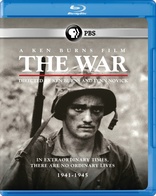The War Blu-ray Movie
HomeThe War Blu-ray Movie 
PBS | 2007 | 840 min | Not rated | May 15, 2012Movie rating
7.9 | / 10 |
Blu-ray rating
| Users | 0.0 | |
| Reviewer | 4.0 | |
| Overall | 4.0 |
Overview
The War (2007)
A seven-part series focusing on the many ways in which the Second World War impacted the lives of American families.
Starring: Tom Hanks, Kevin Conway, Josh Lucas, Adam Arkin, Samuel L. JacksonNarrator: Keith David
Director: Ken Burns, Lynn Novick
| Documentary | Uncertain |
| History | Uncertain |
| War | Uncertain |
Specifications
Video
Video codec: MPEG-4 AVC
Video resolution: 1080i
Aspect ratio: 1.78:1
Original aspect ratio: 1.78:1
Audio
English: Dolby Digital 5.1
English: Dolby Digital 2.0
Subtitles
English SDH
Discs
50GB Blu-ray Disc
Six-disc set (6 BDs)
Playback
Region A (B, C untested)
Review
Rating summary
| Movie | 5.0 | |
| Video | 3.5 | |
| Audio | 4.0 | |
| Extras | 3.0 | |
| Overall | 4.0 |
The War Blu-ray Movie Review
Another masterpiece from the master of the modern Documentary.
Reviewed by Martin Liebman May 13, 2012It was something that had to be done.
World War II has run the gamut of fictional and nonfictional accounts of its conflicts and peoples and turns of events. It's been portrayed as a patriotic,
glamorized event and as a down-and-dirty, all-too-real, harrowing experience. Its stories have been told and told again, embellished here and toned
way down there. Its battles have been studied and picked apart, right down to every last drop of ocean water, every last Pacific island leaf, every last
grain of African sand, every last chunk of European rubble. The commanding officers, the national leaders, and the decorated soldiers have all been the
subjects of countless works in the educational, fictional, and filmed realms. But the story of America back home, how she rose from depression to
defeat the industrialized Nazi Germany at her own game, how farm boys became heroes, how courage triumphed, how the world changed because
America changed it has never been the subject of an in-depth study quite like Documentarian Ken Burns' The War, a grippingly complex and
involved account of World War II as it was fought and, in large part, how it was seen through the eyes of combatants and civilians both from four
corners of American life. Sacramento, California; Mobile, Alabama; Luverne, Minnesota; and Waterbury, Connecticut are the home bases for one of the
most detailed depictions of the war, a depiction that even in its massive length cannot capture all of the smallest details of the war but that
does precisely and with a smooth narrative paint a picture of war on the fields of battle and back home, from start to finish, interconnecting the
massively large scope with a personalization that only Ken Burns could so precisely and narratively effortlessly assemble.
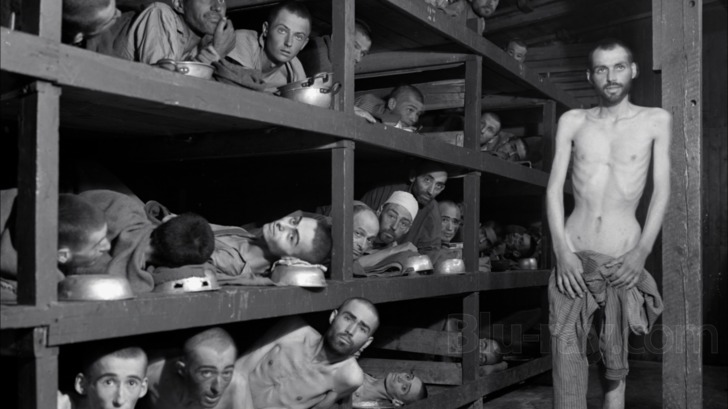
The faces of The Holocaust.
Ken Burns' The War ascends above the average World War II Documentary that's more concerned with facts and figures, dates and times, sweeping generalizations and broad strokes, exciting visuals and nothing audiences haven't seen or heard before -- which is most World War II Documentaries -- rather than a true, involved narrative woven together on the individual level, telling the story of the world's deadliest conflict from the perspective of the everyman, the everyman who fought in the war or experienced it from half a world away. Rather than fictional characters, The War follows the lives of those who won the war and gave and risked their lives in the effort to do so, and how their heroism, life, and death gave further shape to the efforts and stories of their hometowns that were microcosms of the American landscape and the American way of life which helped define and win the war, but also, at times, revealed its weaknesses. The War tells the story of World War II on the fronts of battle and on the home front, where not only an industrial boom and an unflinching dedication of an entire nation played a large part in winning the war, but also where racial strife and imprisonment of a peoples would shape an almost "Twilight Zone"-like tale of a nation on one hand fighting for freedom and equality for all overseas but on the other not securing those same virtues for all those living at home. The stories of every major engagement of the war are interwoven with the evolving tale of American life back home. The hopes, expectations, sacrifices, sadnesses, and joys of people separated by thousands of miles but sharing in common a hometown and a national heritage make up the soul of The War, while still photographs, raw video, and a startlingly detailed narrative -- including pitch-perfect narration from Actor Keith David -- make complete one of the most thorough, fascinating, and well-assembled glimpses into this or any war.
Ken Burns again proves himself as the master documentarian, perhaps the finest such filmmaker of them all. His ability to combine generalizations and broad history with a personal touch and a flowing narrative makes him something of a small-screen professor versed in the story, as knowledgeable as the textbook, and as polished as a professional speaker. His documentaries -- and this one in particular -- are educations condensed into hours and shaped in such a way that audiences come away with a knowledge of a living history, not merely a collection of facts which seem cold and detached from the life narrative. The War is beautifully assembled and paced. It's vivid and highly detailed but easy to soak in. Yet it's incredibly difficult to watch, at times, not because of any Burns stumbles but for quite the opposite. Burns' ability to so accurately depict the war -- and that means its most visually gruesome and emotionally harrowing events and not simply the rah-rah cheerleading and detached combat footage audiences are accustomed to seeing -- will leave audiences in an emotional state that's not often the result of a documentary, but this is nonetheless a rewarding and critical experience for all interested in history and coming to understand World War II, not simply know it. One can only imagine the labor of love that must have been not simply assembling the footage and recreating the World War II story, but doing so with such a personal feel and an unmistakable zeal for the project, for the story and the people who shape it. Burns shares the tales of the individual -- right down to the exact street address -- who would fight and live and die and work and worry and cry tears of sadness and tears of joy through the course of the conflict, depicting them all as if neighbors, friends, family. Burns recreates the home front and the front lines with such accuracy that the film is, at many times literally, a time capsule capturing the intimate details of war in a way never before seen. This is a brilliant, first-class effort that could only have one name attached to it, and that name, of course, is Ken Burns.
The following seven films are included as part of The War:
- A Necessary War (2:22:19): Unlike the devastation that was sweeping Europe and Asia -- German and Japanese soldiers ruthlessly and with incredibly efficiency conquered large areas of land and untold numbers of peoples while leaving behind countless numbers of and paving the way for even more atrocities -- the American home front went relatively unscathed. The people felt safe and far from the troubles plaguing most of the rest of the world. Yet on December 7, 1941, the war came home. A Japanese attack at Pearl Harbor killed thousands of Americans. A shocked populace wanted into the fight. The American military was quickly modernized, industry boomed, and depression gave way to eagerness, manufacturing, and a renewed spirit. German submarines now patrolled and disrupted shipping along American coast lines. A Necessary War examines the early stages of American involvement in the war, including the Japanese siege of Corregidor, the Bataan Death March, American victories at Midway and the costly push through Guadalcanal, the preparations for the North African campaign, and the American internment of Japanese civilians.
- When Things Get Tough (1:54:48): With the United States fully committed to the war effort and having been involved for a year, the Allies launch a major offensive into the outskirts of Nazi-held territory in Northern Africa. American forces are swiftly and decidedly crushed in the earliest fighting, but a change at the top -- the arrival of General George S. Patton -- results in a better-prepared American ground force and yields a major victory in the war's southern front. Later, Americans make a push into Italy, hoping to cripple a key Nazi ally and reclaim critical territory within Europe itself. When Things Get Tough also focuses on the ever-dangerous B-17 bombing raids over Nazi-controlled territory, life for American and allied POW's inside harsh Japanese camps, and the life of Japanese-Americans interned within the United States. Also featured is life on the home front, the revitalization of the economy, vanishing unemployment, the mass production of military goods, the role of American women in the war effort, and shortages and rationing of both luxury and staple goods.
- A Deadly Calling (1:50:17): Deep into the war, and finally brutal pictures of combat and dead American soldiers appear in LIFE Magazine and, later, upon cinema screens in government-approved video clips of the Italian campaign which show firsthand the brutality of war, a glimpse into the conflict the American people could have never imagined from the safety of places like Luverne, Mobile, Sacramento, and Waterbury. As the deadly Italian campaign pushes forward, Allies circumvent enemy forces on land and launch a sneak attack into the heart of Nazi-held territory at a little seaside city called Anzio. Meanwhile, in the Pacific, the war effort against the Japanese Empire continues, with a key battle fought over the small atoll of Tarawa. Back home, the story of interned Japanese-Americans continues to evolve, and racial strife, violence, and discrimination continues even as the nation exists on a war footing and needs every able-bodied individual to contribute to the war effort. A Deadly Calling lays the groundwork for Japanese-American and African-Amaerican troops in the war, while also looking at the boom in manufacturing, scrap drives, and further sacrifices on the home front.
- Pride of Our Nation (2:16:50): By the Spring of 1944, the tide of the war had changed. The Allies were making great strides across the Pacific, and much of North Africa and Italy lay under Allied control. But for all the successes, one more major move remained to be made: a coastal invasion of France. On the morning of June 6, 1944, Allied soldiers from Canada, England, and the United States landed ashore on France, the Americans in particular facing heavy resistance. But the day was won and the grueling but necessary fight to drive the Nazis from Germany was underway. Pride of Our Nation also takes a long look at the public reaction to the long-awaited invasion across the United States, both the celebratory initial reaction and the tragedy of the influx of KIA notices to follow. Meanwhile, on the other side of the world, American forces continued their island-hopping push towards mainland Japan. The target for the Summer of 1944 was Saipan, a heavily-defended island and home to Japanese civilians, not just well-entrenched and dedicated soldiers. The Allies also won a major naval victory against the Japanese Empire at the Battle of the Philippine Sea, a battle which would turn the tide of the Naval conflict in the Pacific once and for all.
- FUBAR (2:04:21): By the middle of 1944, the push deep towards Germany was well underway, and Allied forces were under the assumption that the European war would be over by Christmas of that year. But things don't always go according to plan. Operation Market Garden was conceived as a plan to win the war in weeks, not months, to strike deep at the industrial heart of the German empire and finsih the thrust forward towards Berlin. But it proved to be a disastrous operation, "the best laid plans" and whatnot, a major setback for the Allies and a major, morale-boosting triumph for the Germans following the Allied successes in the wake of of D-Day. Meanwhile, Marines continued the difficult island-by-island trek through the Pacific and towards Japan. The latest target: Peleliu. Also: Japanese prisoners of war find hope in the skies; General MacArthur makes good on his promise to return to the Philippines; the Battle of Leyte Gulf, thought to be the largest naval engagement in history, is fought; and additional Eastward pushes towards Germany are highlighted.
- The Ghost Front (1:56:51): By the end of 1944, victory was still out of reach in Europe -- contrary to popular belief earlier in the year and following the costly but successful invasion of France -- and the battle for the Pacific was far from won. Soon, the Pacific fighting would reach a small volcanic island called Iwo Jima, a critical midway point between Allied-control territory and mainland Japan. The battle for control of it would yield one of the bloodiest campaigns in U.S. military history. Meanwhile, in Europe, Hitler planned a daring counter-attack in the Ardennes Forest to slow, or prevent, the Allied advance. His plan: push westward, cut north, and drive the Allies out of Europe and into the sea. But the German brass was unsure of the plan. The German military was spread thin and her war machine low on material. Men of all ages and abilities were drafted, and the result was a costly, frigidly cold, and bloody confrontation that would come to be known as "The Battle of the Bulge." Meanwhile, prisoners of war in Manila finally taste freedom. This film also examines the role of medics in the war, the psychological repercussions of war, the Yalta Conference, the Allied firebombing of Germany and Japan, and the Allied push deep into Germany herself.
- A World Without War (2:05:03): The lengthy war was taking its toll on all, including U.S. President Franklin Delano Roosevelt, who would die suddenly on April 12, 1945. His successor, Harry S. Truman, would not simply preside over the waning days of war, but he would be faced with a decision that would forever change the face of warfare, alter the world's military and political power structures, and usher in a new era of incredible might in the form of the tiny atom. In Europe, Nazi Germany was being squeezed on both fronts, with quickly-advancing Soviet forces to the east and Western forces coming in from the west, with final destruction or surrender seemingly the only choices for the Third Reich. In the Pacific, U.S. forces prepared for an assault of Okinawa, "the gateway to Japan," and a victory on that island would mean only the prospect of an invasion of mainland Japan, that invasion predicted to see the deaths of countless thousands, if not millions, of fighting forces and civilians, or the use of a radically advanced weapon that could destroy an entire city with a single blow. Also: Japanese kamikaze attacks; the liberation of Nazi concentration camps; the Potsdam Conference; the sinking of the U.S.S. Indianapolis; and post-war celebrations and life in Waterbury, Connecticut; Sacramento, California; Mobile, Alabama; and Luverne, Minnesota.
The War Blu-ray Movie, Video Quality 
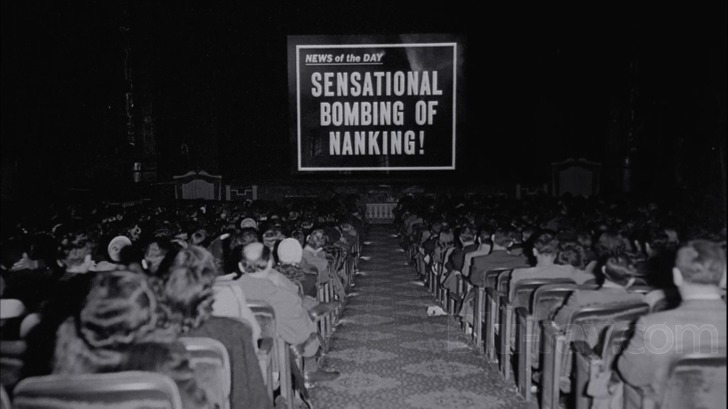
The War's Blu-ray presentation is a mixed bag of elements. Burns' film contains newly-constructed HD interview and town footage, old photographs, and antique film footage, most in black-and-white, some in color, the latter seen primarily in footage from the late Pacific fighting. As always, the wear-and-tear and natural state of the classic materials will not factor into the overall score. Needless to say, much of the older film footage is riddled with pops and scratches and softness and jagged edges and edge halos, all the sorts of wear anyone familiar with that vintage newsreel film footage has seen before. The photographs, on the other hand, are often crisp and very nicely defined if not a little scratchy here and there. These photographs capture people, building fašades, wartime devastation, even overhead views of cities with great clarity, allowing for a colorless but accurate representation of the way things were. The newer footage isn't quite perfect. Grain is rather sharp and spiky, but interviewee facial details are complex. Flesh tones are a little pasty and rosy, while black corners of the frame appear a hair dark and are prone to breaking down into blockiness. Light edge enhancement and shimmering are also evident on newer elements. For the most part, however, this one is defined by the older material created during the war. In true Ken Burns style, the old meshes naturally with the new, and the jump from shaky black-and-white footage to sharp and colored HD material is never as jarring as it sounds thanks to the quality of the narrative. Still, this isn't a pristine image by any means, but it's fine for what it is and is a quality component in the greater The War high definition experience.
The War Blu-ray Movie, Audio Quality 

The War features a surprisingly active and exciting Dolby Digital 5.1 soundtrack. The track is defined by several primary elements, the first being the spoken word, including Keith David's narration, the occasional voiceover of another actor, and interviewee sound bytes. The clarity and delivery are perfect, grounded in the center, and always balanced with surrounding elements, though to be sure heavier music and effects don't often play at the same time with narration. Period music plays with vigor and fine clarity; many of the era's hits energetically swing through the soundstage, and often with a surround element in support. There are instances where the music plays with a slightly shallow tenor, but the presentation is mostly top-tier. Nice, light bass in music and effects give the track a positive body and a sense of completeness. Varied support sound effects have been expertly inserted into the film and nicely reproduced on Blu-ray. For instance, still photographs and news reel footage playing in theaters are often accompanied by the whirring sound of the projector across the back. But the most active and intense element to be found comes in the form of the recreated sounds of war. The War places buzzing planes, rattling machine guns, flying bullets, exploding objects, and screaming men into the stage in an effort to bring a more vivid and accurate life to the moving footage and still photographs. Planes zoom from side to side, gunfire erupts form every corner, and explosions pack a hefty wallop. The sounds have been painstakingly engineered and fit the narrative wonderfully. To be sure, this is no Saving Private Ryan -- nor should it be -- but the presentation is excellent on all fronts.
The War Blu-ray Movie, Special Features and Extras 
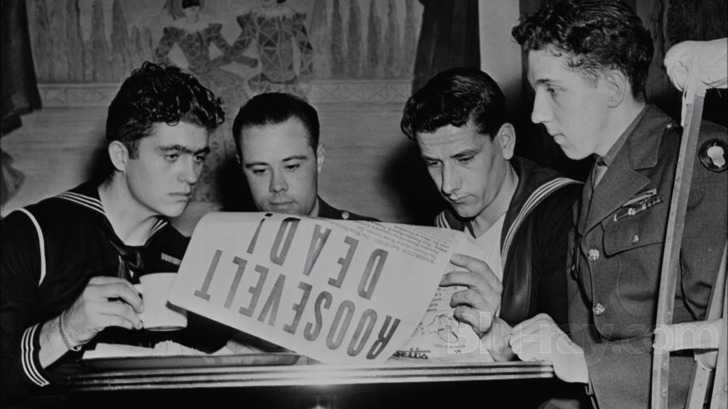
The War contains two audio commentaries, a fine making-of, deleted scenes, and additional interviews. All but the commentaries appear on
disc six.
- Audio Commentaries: Ken Burns and Lynn Novick discuss Episode One, A Necessary War; and Episode Four, Pride of Our Nation.
- Making The War (480p, 36:24): Burns, Novick, and others discuss the conflict. They also speak on the purposes behind making this documentary and the process of creating it, including choosing the four towns featured in the film, the benefits of the approach, interviewing veterans, creating new footage, assembling and organizing archival footage, the challenges of retelling major battles, mixing the film's sound effects, and crafting the score.
- Deleted Scenes (480p, 44:18): War Correspondents, Attacks on Aachen and Metz, Flies, Al McIntosh on Sacrifice, Sid Phillips Writes Home, Order 9066, Breaking Out of the Hedgerows, War Town, Wax Work, Jim Thomas Dies, Fussell Kills, The Old Country, Operation Cobra, Sam Hynes on Okinawa, Inouye's Lucky Dollar, Returning Fathers, and Sascha Comes Home.
- Additional Interviews (480p, 55:26): Quentin Aanenson, Asako Tokuno, Barbara Covington, Joe Medicine Crow, Paul Fussell, Tom Galloway, John Gray, Sam Hynes, Daniel Inouye, Sascha Weinzheimer, Jim Sherman, Burnett Miller, Bill Lansford, and Katherine Phillips.
The War Blu-ray Movie, Overall Score and Recommendation 
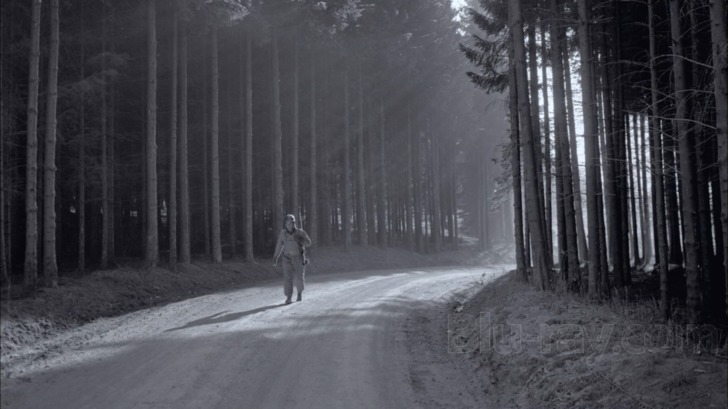
The War represents the pinnacle of wartime filmmaking. It's Documentary perfection, and while it may or may not be Burns' finest achievement -- his The Civil War and Baseball are rightly cherished as Documentary pinnacles -- it's arguably the finest World War II Documentary in existence, certainly the most narratively gripping and expertly assembled. It's detailed but personal, intricate but easy to take in. The flow is beautiful, Keith David's narration is the perfect match, and the scope and length are just right. Whether for classroom use or for those who want to bring the classroom home, The War is an education, an enlightenment, even entertainment all in one incredible package. This Paramount/PBS Blu-ray release of The War features quality video and audio. The supplements are a bit on the thin side, but all told this is a must-own release that comes very highly recommended.
Similar titles
Similar titles you might also like

The Vietnam War
2017

The World at War
1973

WWII in HD
World War II in HD
2009

The World Wars
2014

Korengal
2014

Last Days in Vietnam
American Experience: Last Days in Vietnam
2014

They Shall Not Grow Old
2018

Hearts and Minds
1974

Ken Burns: The Civil War
1990

The Battle of San Pietro
San Pietro
1945

Untold History of the United States
Oliver Stone's
2012-2013

Cease Fire 3D
1953

Restrepo
2010

The Cold Blue
2018

Vietnam in HD
2011

America: The Story of Us
2010

Hell and Back Again
2011

Gettysburg
2011

Apocalypse: World War II
2010

Victory at Sea
Deluxe Edition
1952-1953
